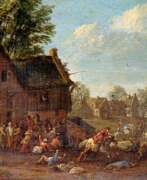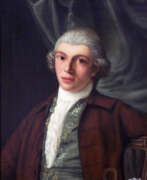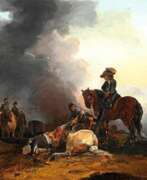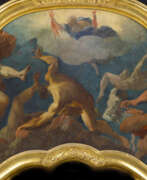Batalists 18th century


Romolo Panfi was an Italian painter, of the late Baroque period, active mainly in Florence. He was active mainly as a battle painter and landscapes. He was a pupil of Jacopo Vignali and worked in the Medici court of Grand Duke Ferdinand and his brother, Cardinal Leopoldo de' Medici. He trained under Giovanni Camillo Sagrestani. He executed works in the church of San Frediano in Cestello, in the Oltrarno district of Florence. He also painted for the Palazzo Capponi-Covoni near the Nunziata in Florence.






Alexander Ivanovich Dmitriev-Mamonov (Russian: Александр Иванович Дмитриев-Мамонов) was a Russian military commander and battle painter, known for his significant contributions both in the military and in the arts. Born on December 24, 1787, in Saint Petersburg, he was the son of Major-General Ivan Dmitriev-Mamonov. His early career saw him serving as an actuary at the Collegium of Foreign Affairs and later at the State Chancellery.
Dmitriev-Mamonov joined the People's Militia in 1812, rising to the rank of Lieutenant and participating in key battles such as Borodino and Krasnoi during the Napoleonic Wars. By 1823, he was promoted to Colonel and subsequently to Major-General in 1831, commanding various cavalry regiments. Apart from his military endeavors, Dmitriev-Mamonov was also an accomplished amateur artist. He co-founded the Imperial Society for the Encouragement of the Arts and established a drawing school in 1827. His battle sketches and watercolors are prominently displayed in Tsarskoye Selo.
In 1835, he transitioned to civil service, becoming a State Councillor at the Ministry of Internal Affairs. His notable awards include the Order of Saint Vladimir, Order of Saint Anna, and the Medal "For the Capture of Paris." Dmitriev-Mamonov's legacy is preserved through his artistic works and his contributions to Russian military history.
For more updates on auctions and sales related to Alexander Ivanovich Dmitriev-Mamonov's works, sign up for our newsletter to stay informed about new product sales and auction events.


Johann Jakob Haid, a prominent German engraver and portraitist, was renowned for his work in Augsburg during the 18th century. Born into a family of artists, Haid's legacy is particularly noted for his exquisite mezzotint portraits. His career also involved a stint in England, where he was influenced by the works of English mezzotint engraver Robert Robinson.
Haid's artistic prowess was not limited to portraiture. He ventured into botanical illustration, contributing significantly to Johann Wilhelm Weinmann's "Phytanthoza iconographia". This collaboration showcases his versatility and technical skill in different art forms.
Collectors and experts in art and antiques often seek Haid's works for their unique artistic value and historical significance. His contributions to the art world, especially in mezzotint engraving, continue to be appreciated and studied. His works are a testament to the rich cultural and artistic heritage of Germany.
For those interested in the world of art and antiques, particularly in the realm of engraving and painting, Johann Jakob Haid remains a figure of significance. To stay updated on new product sales and auction events related to Johann Jakob Haid, sign up for our updates. This subscription is an excellent way to stay informed about the latest developments and opportunities in the field.


Isidore Stanislas Henri Helman was a French painter and engraver.
Among other works, Helman published an abridged version of the album Conquests of the Emperor of China, which was originally printed in an edition of only 200 copies, almost all of which were sent to Emperor Qianlong. Helman developed an interesting style of depicting Chinese art and Chinese subjects aimed at a European audience.


Carl Adolph Heinrich Hess was a German animalist, battalionist and teacher. He studied the works of the old masters at the Dresden Gallery.
Carl Adolph Heinrich Hess travelled extensively in Russia, Hungary, Turkey and Britain, studying different breeds of horses and achieved mastery in their portrayal.
He lived in Vienna from 1808, where he taught at the Academy of Fine Arts. In 1825 he published a collection of life-size lithographs of horse heads.
He was an honorary member of the Berlin Academy of Arts.


Mikhail Matveevich Ivanov (Russian: Михаил Матвеевич Иванов) was a Russian painter and watercolorist, born in 1748 in St. Petersburg. He is recognized for his landscape and battle scene paintings. Ivanov's early training was at the Imperial Academy of Arts, where he studied under Ivan Groot and later, Jean-Baptiste Le Prince in Paris. His works often depicted detailed landscapes and significant historical events.
Ivanov earned acclaim for his watercolors and drawings, many of which are housed in the State Russian Museum and the Hermitage Museum. Notable works include "View of Three Churches Against the Backdrop of Mount Ararat" and "Russian Fleet in the Bosphorus Strait".
Collectors and art enthusiasts highly regard Ivanov's contribution to Russian art, particularly his ability to capture the essence of the landscapes and historical moments of his time. To stay updated on new works and auction events related to Mikhail Matveevich Ivanov, sign up for our updates.


Johannes Hermanus Koekkoek was a Dutch painter and draughtsman. Following his education, he worked as an art teacher, but soon decided to become a free-lance artist. In 1826, he moved to Durgerdam, near Amsterdam, where he would live and work until 1833. He initially combined seascapes and cityscapes but, in his later years, focused entirely on ocean scenes. Much of his inspiration came from the painters of the Dutch Golden Age. His style was essentially Realistic, but alos showed elements of the newer Romantic aesthetic. Rather than merely paint ships, he also learned as much as he could about the different types.


Johann Peter Krafft was a German and Austrian painter of the mid-nineteenth century. He is known as a painter and graphic artist who specialized in genre, battle, portraiture and history painting. Krafft is believed to have had a significant influence on Austrian painting and was a leading portraitist of the Neoclassical style in Vienna. He later influenced the development of genre painting during the Viennese Biedermeier period.
Krafft co-founded the Vienna Artists' Union and was elected to the council of the Vienna Academy of Art in 1835. The artist also acted as a consultant for the protection of cultural monuments at Karlstein Castle in Bohemia.


Thomas Luny was an English artist and painter, mostly of seascapes and other marine-based works. At the age of eleven, Luny left Cornwall to live in London. There he became the apprentice of Francis Holman, a marine painter who would have a great and long lasting artistic influence on Luny.


Aleksander Orłowski (Russian: Александр Осипович Орловский), a renowned Polish painter and sketch artist, was born on March 9, 1777, in Warsaw, within the Polish-Lithuanian Commonwealth. His journey into the arts began under challenging circumstances; he was the son of a tavern-keeper and his family was not wealthy. His early promise in art was nurtured by noble patron Izabela Czartoryska, who financed his initial education under the guidance of artist Jan Piotr Norblin.
Orłowski's artistic journey intersected with his military service during the Kościuszko Uprising, a major revolt against Imperial Russia and Prussia in 1794. This period of conflict significantly influenced his later works, which often depicted military scenes and the daily life of soldiers. After the partitions of Poland, Orłowski moved to Saint Petersburg in 1802, where he became a seminal figure in the development of lithography in the Russian Empire.
His oeuvre includes a wide array of subjects, from battle scenes to cultural depictions of everyday life in both Poland and Russia. Notable works such as "Battle Scene" and "Cossack Fighting Off A Tiger" showcase his skill in capturing dynamic movement and drama. His works are preserved in esteemed institutions such as The Russian Museum and The Tretyakov Gallery, highlighting their historical and artistic value.
Orłowski's impact extended beyond the canvas; he was also mentioned in literary works by notable authors like Adam Mickiewicz and Alexander Pushkin, which underscores his cultural significance in the 19th century.
For collectors and experts in art and antiques, Aleksander Orłowski's works represent a crucial segment of Eastern European art history. To stay informed about new discoveries or auction events related to his works, consider subscribing for updates. This subscription ensures you receive timely information tailored to your interests, directly relating to new sales and significant events around Orłowski's art.


Jan Willem Pieneman was a painter from the Northern Netherlands. In 1805 he was appointed as drawing instructor at the artillery and engineering training centre in Amersfoort. He was particularly noted for his paintings depicting events from the history of the United Kingdom of the Netherlands. His fame was established by a painting he did at the Villa Welgelegen, depicting the heroic acts of the Prince of Orange at the Battle of Quatre Bras, followed by a painting of the Battle of Waterloo. The latter found favor with the Duke of Wellington, who invited him to England, on several occasions, to do portraits. In 1820 he was appointed as first director of the Royal Academy of Fine Arts (Koninklijke Academie voor Schone Kunsten) in Amsterdam. He played an important role as mentor and tutor to a group of young artists.


August Querfurt was an Austrian painter. He painted primarily soldiers and battle scenes. He was first instructed by his father, Tobias Querfurt, a landscape and animal painter, and afterwards studied under Rugendas at Augsburg. He painted encampments, battles, skirmishes of cavalry, and hunting subjects, in all of which he appears rather as an imitator than as an original painter. He sometimes imitated the manner of Bourguignon , Parrocel, and Van der Meulen, but more especially sought to form his style after Wouwerman. He died at Vienna in 1761.


Alexander Ivanovich Sauerweid (Russian: Александр Иванович Зауервейд) was a Baltic German painter born on February 19, 1783, in the Duchy of Courland and Semigallia. He is best known for his detailed battle scenes and military portraits, which earned him significant acclaim in the 19th century. His early education in the arts took place at the Dresden Academy of Fine Arts, where he developed a strong foundation in painting.
Sauerweid's talent for depicting military subjects brought him to the attention of prominent figures of his time, including Napoleon and Tsar Alexander I of Russia. Invited to Saint Petersburg in 1814, Sauerweid became the official painter of the Russian General Staff and later a professor at the St. Petersburg Imperial Academy of Arts. His role involved teaching battle painting and producing works that depicted various military uniforms and scenes, a specialty that set him apart from his contemporaries.
Among his notable works are "The Battle of Leipzig" and "The Siege of Varna," which showcase his ability to capture the dynamism and drama of military engagements. Many of Sauerweid's paintings are housed in Russian Imperial Palaces, reflecting their historical and artistic value.
For collectors and enthusiasts, keeping abreast of Alexander Ivanovich Sauerweid's works is essential. Subscribe to our updates to be the first to know about new product sales and auction events related to this distinguished artist. Sign up now!


Jan van Huchtenburgh was a Dutch painter of the Dutch Golden Age who specialised in battle scenes and landscapes.
Jan van Huchtenburgh was known for his ability to create dramatic and dynamic battle scenes, often depicting historical events of the 17th and 18th centuries. His work is noted for its precision and attention to detail, as well as his use of light and shadow to create a sense of depth and drama.
In addition to battle scenes, Huchtenburg was also a skilled landscape painter. He often depicted scenes of the Dutch countryside with rolling hills, winding rivers and expansive skies.


Jan van Os was a Dutch painter and a member of the renowned Van Os family of artists. He was born in Middelharnis. He was taught by Aert Schouman in The Hague, where he would spend the rest of his life. In 1773, he recorded in the painters' confraternity. Van Os is mostly known for his fruit and flower still life paintings, though he started his career painting seascapes. His floral still lifes were painted in the style of Jan van Huysum, with the flowers usually presented on a marble ledge against a green background. He was the father of artists Pieter van Os, Maria Margaretha van Os, and Georgius Jacobus Johannes van Os and grandfather to the painter Pieter Frederik van Os.


Peter von Hess was a Bavarian painter of the 19th century. He is known as a court battle-painter and master of historical painting.
Peter von Hess took part in the military campaign of 1813-1814 against Napoleon and after a tour of Vienna, Switzerland and Italy founded his workshop in Munich. At first he depicted small scenes from the life of soldiers, and then he moved on to creating large battlefield paintings. In 1839, the artist visited Russia to create a series of paintings of the main battles of 1812 commissioned by Emperor Nicholas I.
Hess's works are notable for their vivid composition, fine characterization of figures and drama.


Wilhelm von Kobell was a German painter of the first half of the 19th century. He is known as a landscape painter, animalist and battle painter.
Von Kobell initially produced landscapes and animal paintings, but later focused mainly on battle painting. He visited Vienna and Paris between 1809 and 1810 to study this genre. His battle paintings, based on extensive research, are characterized by striking realism. They are important for the study of military history.









































